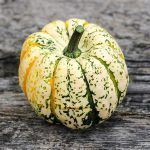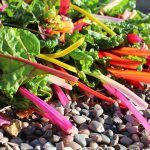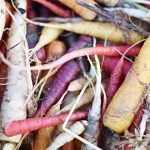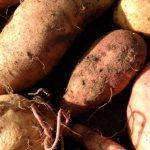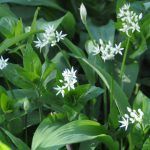The leanest time of year in the vegetable garden is not the depths of winter but now, in early spring. Stored produce is dwindling, past its best or has run out altogether. The same is true for crops that overwinter such as parsnips, leeks and kale. Thank goodness for sprouting broccoli, which is just starting to get underway. Likewise for last year’s ‘Crown Prince’ squashes and the ‘Romano’ potatoes, which keep astonishingly well.
There’s not much else though and anything sown so far this year is still a way off being ready. Various salad leaves will arrive first but there’ll be nothing really substantial till early potatoes and broad beans at the start of June. That’s a long time. This is the famous ‘Vegetable Gap’ or even “Hungry Gap’, as some call it. It’s particularly bad this year, since winter has really outstayed its welcome. As for trusty perennials, the rhubarb is up but running very late but I can’t see there being much asparagus this month.
We’re lucky these days: we have freezers, tinned goods and fresh food grown in polytunnels or flown in from abroad. Before all that, people really did run the risk of starving if a harvest failed, a winter was overlong or if a marauding army requisitioned their stores. Foraging for wild food in fields and hedgerows was an absolute necessity. I can’t claim to be an expert but there are some things I look for every year and my repertoire is gradually expanding. I’m going to feature one such plant now and some others in the coming weeks.
This week’s star is the less than enticingly named Hairy Bittercress (Cardamine hirsuta). It’s the earliest useful edible weed and a member of the cabbage family. The photograph shows it nestling next to an overwintered lettuce in Jamie’s polytunnel. The sheltered environment means that these specimens are particularly large and lush. Growing 20cm high at most (though usually much less), it forms a neat little rosette of leaves and bears small white flowers (also edible).
It germinates year-round but especially in summer and autumn, and favours bare ground: vegetable beds, paths, pots, greenhouse borders, the shingle on my drive and even dunes and walls. It is frost-hardy and available through the winter but is at its best in spring once it starts growing properly. The flavour is very pleasant, like a less peppery version of watercress. Incorporate it into salads or stick it in a cheese sandwich.
Lastly, and without getting too preachy (though it is something I care about), do please look at labels to see where fresh food has been flown in from and choose those with lower food miles. In particular, please don’t buy foreign asparagus during the British season, which usually runs from mid-April till mid-June. You’d be surprised how many shops still stock imported spears at this time.
Lastly lastly, a word about the title. I’m a sucker for a good (or indeed bad) pun and the title here seemed the obvious one to go for. It turns out that Joy Larkcom has already used it. For those that don’t know her books, what she doesn’t know about growing vegetables isn’t worth knowing. So, I apologise, pleading a similar sense of wordplay at best and unintentional plagiarism by osmosis at worst.


